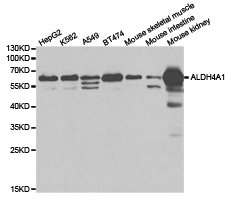ALDH4A1 Rabbit Polyclonal Antibody
Frequently bought together (2)
Transient overexpression lysate of aldehyde dehydrogenase 4 family, member A1 (ALDH4A1), nuclear gene encoding mitochondrial protein, transcript variant P5CDhL
USD 396.00
Other products for "ALDH4A1"
Specifications
| Product Data | |
| Applications | IF, IHC, WB |
| Recommended Dilution | WB 1:500 - 1:2000, IHC 1:50- 1:200, IF 1:50- 1:200 |
| Reactivities | Human, Mouse, Rat |
| Host | Rabbit |
| Isotype | IgG |
| Clonality | Polyclonal |
| Immunogen | Recombinant protein of human ALDH4A1 |
| Formulation | Store at -20C or -80C. Avoid freeze / thaw cycles. Buffer: PBS with 0.02% sodium azide, 50% glycerol, pH7.3 |
| Concentration | lot specific |
| Purification | Affinity purification |
| Conjugation | Unconjugated |
| Storage | Store at -20°C as received. |
| Stability | Stable for 12 months from date of receipt. |
| Gene Name | aldehyde dehydrogenase 4 family member A1 |
| Database Link | |
| Background | This protein belongs to the aldehyde dehydrogenase family of proteins. This enzyme is a mitochondrial matrix NAD-dependent dehydrogenase which catalyzes the second step of the proline degradation pathway, converting pyrroline-5-carboxylate to glutamate. Deficiency of this enzyme is associated with type II hyperprolinemia, an autosomal recessive disorder characterized by accumulation of delta-1-pyrroline-5-carboxylate (P5C) and proline. Alternatively spliced transcript variants encoding different isoforms have been identified for this gene. |
| Synonyms | ALDH4; P5CD; P5CDh |
| Reference Data | |
| Protein Families | Druggable Genome |
| Protein Pathways | Alanine, aspartate and glutamate metabolism, Arginine and proline metabolism, Metabolic pathways |
Documents
| Product Manuals |
| FAQs |
| SDS |
{0} Product Review(s)
0 Product Review(s)
Submit review
Be the first one to submit a review
Product Citations
*Delivery time may vary from web posted schedule. Occasional delays may occur due to unforeseen
complexities in the preparation of your product. International customers may expect an additional 1-2 weeks
in shipping.






























































































































































































































































 Germany
Germany
 Japan
Japan
 United Kingdom
United Kingdom
 China
China







